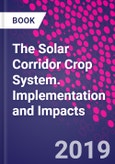The Solar Corridor Crop System: Implementation and Impacts presents a case-study format on the planning and implementation of alternative cropping systems designed to maximize incident sunlight and bio-support of all crops in a rotation system. The book describes the basic component of the system, an increased access point of incident sunlight between each row or pairs of rows that enables a more uniform vertical distribution of incident sunlight to chloroplasts within the entire corn leaf canopy. While the production environment and environment specific genetics determine the performance potential of this principle, by maximizing the principles that light is basic to crop yield, a solar corridor ultimately contributes to increased grain yield.
Written by experts who were integral in the development of solar corridor systems, and providing real-world examples of the methods, challenges and future prospects, this book will be valuable for those seeking to increase yield-per-acre through both primary and cover-crops.
Please Note: This is an On Demand product, delivery may take up to 11 working days after payment has been received.
Table of Contents
1. Crop production: Solar radiation and carbon dioxide as fundamental components for growth and economic yields 2. Crop production: Planting arrangement, plant density, and varietal selection for high yields 3. Water-use efficiency in cropping systems 4. Alternative cropping systems and impacts on rural community development and food deserts 5. The solar corridor concept and setting goals to double corn yield 6. The solar corridor: site-specific production environment 7. The solar corridor: varietal selection and optimum plant populations for the production environment 8. The solar corridor: selecting and establishing floor crop cultivars 9. Soil quality benefits of the solar corridor crop production system 10. Fine tuning the solar corridor crop production system for production environments 11. Solar corridor crop production and benefits to mankind and Earth 12. A practical guide for setting up the solar corridor adaptable to any crop production system 13. The unprecedented opportunity
Authors
C. LeRoy Deichman Interdisciplinary Corn Production Agronomist, Deichman Consulting. C. LeRoy Deichman, Interdisciplinary Corn Production Agronomist, Deichman ConsultingDeichman's primary agronomic interests lie in 1.)interactions and resulting synergies within and between the corn production environment and the phenotypes that express it, 2.) the most limiting factors in state of the art corn production and 3.) an innovative vision for what lie ahead. e.g. Deichman and Murrell and Deichman and Barrett, '77 and '78, respectively identified synergies between specific soil fertility parameters and specific genetics, setting the stage for subsequent work that has since come forth on the subject. Deichman and Warsaw, '88 did the same for the solar Corridor's specific light enriched production environment. Initially with clients of Deichman Consulting, Deichmann Maize Research,Inc. and Maize Research Unlimited, respectively, Deichman directed the seminal research on the SCCS and holds the Core Patent and 4 synergistic patent applications pending submission. Robert J. Kremer School of Natural Resources, University of Missouri, Columbia, MO, USA. Robert J. Kremer is an Adjunct Professor, Environmental Soil Microbiology, School of Natural Resources, University of Missouri, Columbia, MO
Dr. Kremer's primary research area is the relationship among soil properties, plant growth, and soil microorganisms as influenced by crop and soil management practices. Management under sustainable (agroforestry, cover cropping, inter-cropping, organic), conventional agriculture (including genetically-modified crops), and grassland restoration systems is assessed for effects on soil quality using microbial, chemical, and physical parameters as indicators. Impacts of xenobiotics (pesticides, antibiotics) on soil biology and soil health are evaluated and management for reducing detrimental effects are developed. Soil microbial properties with beneficial and detrimental effects on plant growth, including weed and pathogen biological control potential are examined.








